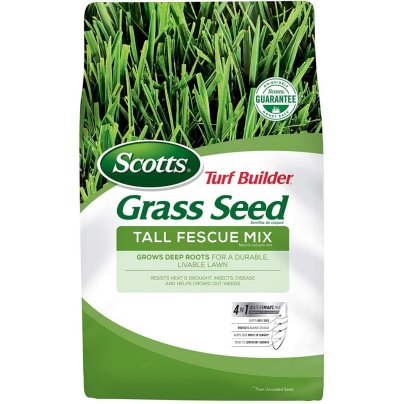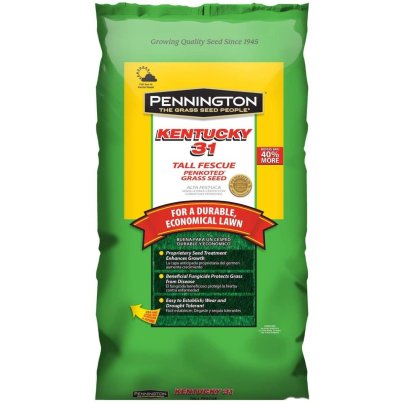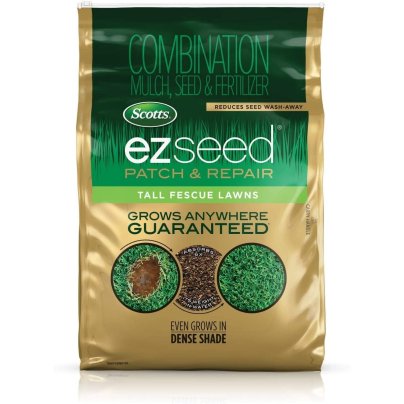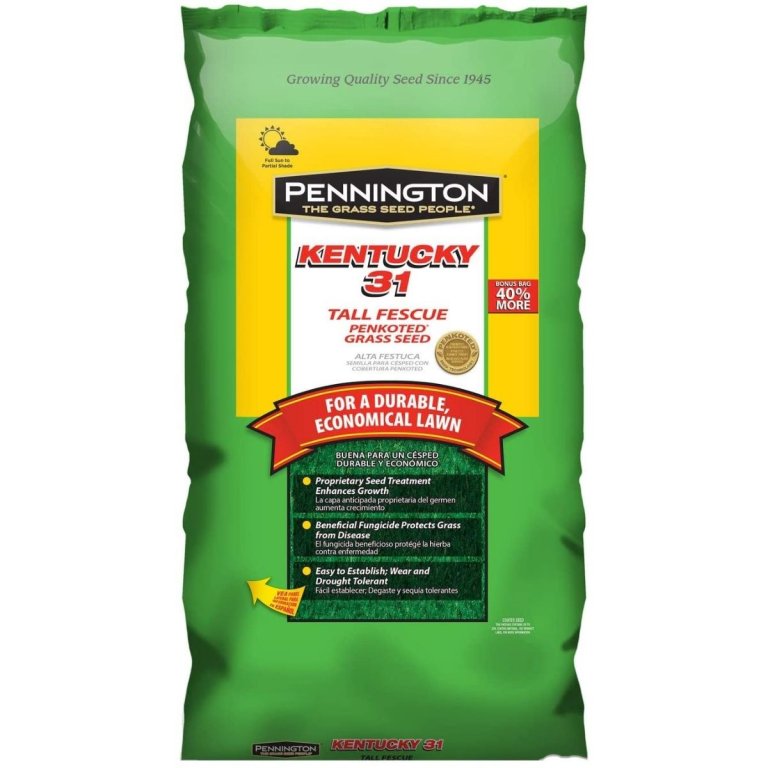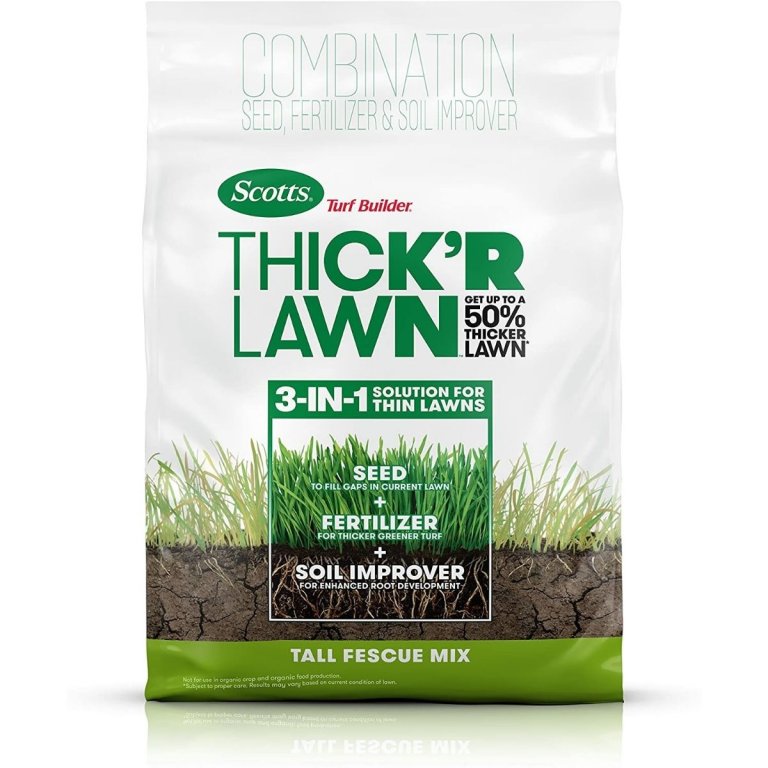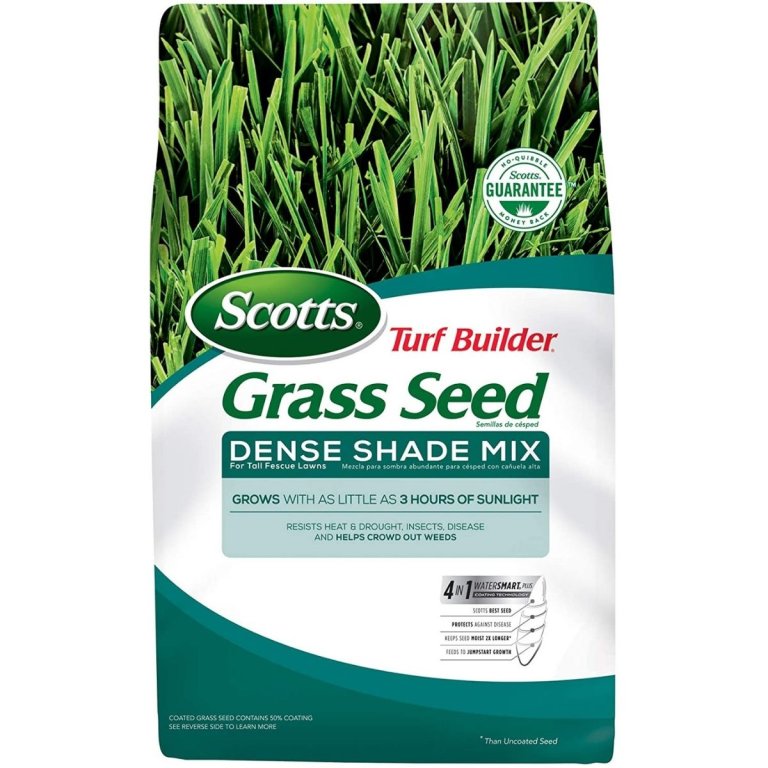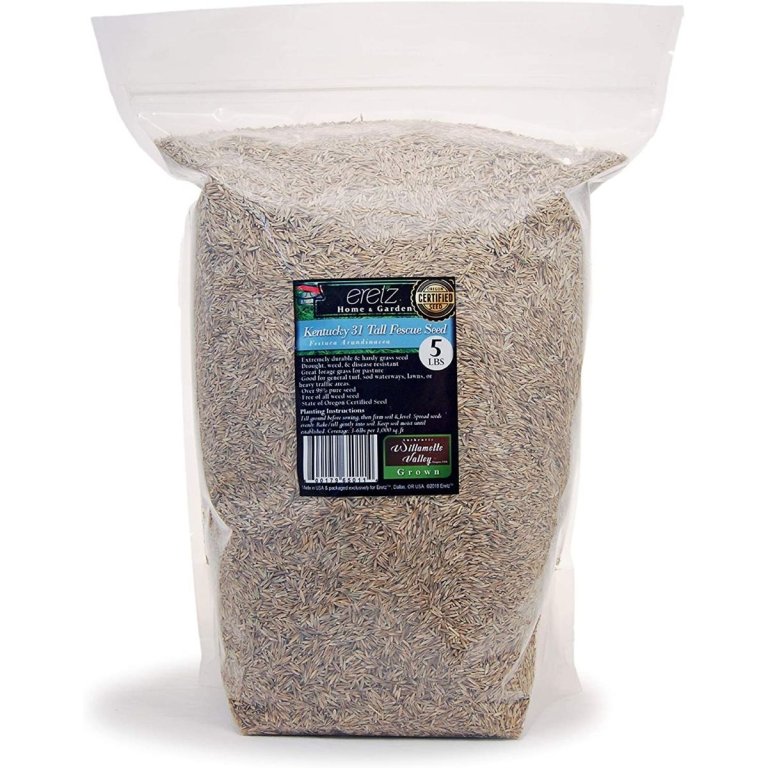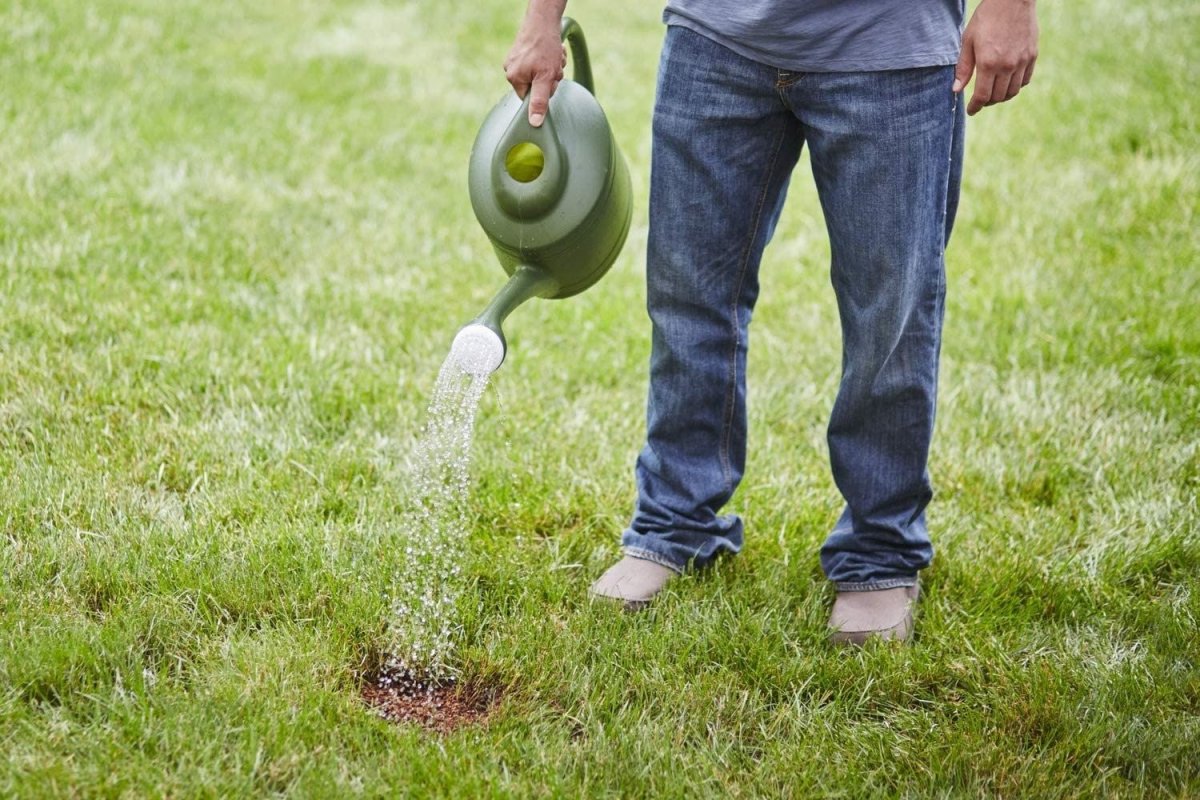
We may earn revenue from the products available on this page and participate in affiliate programs. Learn More ›
One of the most popular grass types, tall fescue, which is native to the European continent, was first brought to the U.S. in the early 1800s. The fescue genus (Festuca spp.) includes about a hundred varieties of grass. Tall fescue varieties number in the dozens, with more currently in development in the quest for the hardiest lawn seed.
Tall fescue lawns are sometimes established by laying sod, but because tall fescue is a fast-growing grass, it is most often grown by seed. The best tall fescue grass seed will vary, depending on the climate and the environment. Some varieties will grow in deep shade, while others prefer full sun and are more tolerant of drought and heat. In general, tall fescue varieties are best suited to lawns in the nation’s northern half, although there are some exceptions.
Ahead, learn more about this beautiful emerald green grass and find out why the following fescue seed products are among the best options for a variety of lawn situations.
- BEST OVERALL: Scotts Turf Builder Grass Seed Tall Fescue Mix, 7 lb.
- RUNNER UP: Pennington Kentucky 31 Tall Fescue Grass Seed
- BEST FOR BARE SPOTS: Scotts EZ Seed Patch and Repair Tall Fescue Lawns
- BEST FOR LAWN THICKENING: Scotts Turf Builder Thick’R Lawn Tall Fescue Mix
- BEST FOR SHADE: Scotts Turf Builder Grass Seed Dense Shade Mix
- ALSO CONSIDER: Eretz Kentucky 31 K31 Tall Fescue Grass Seed
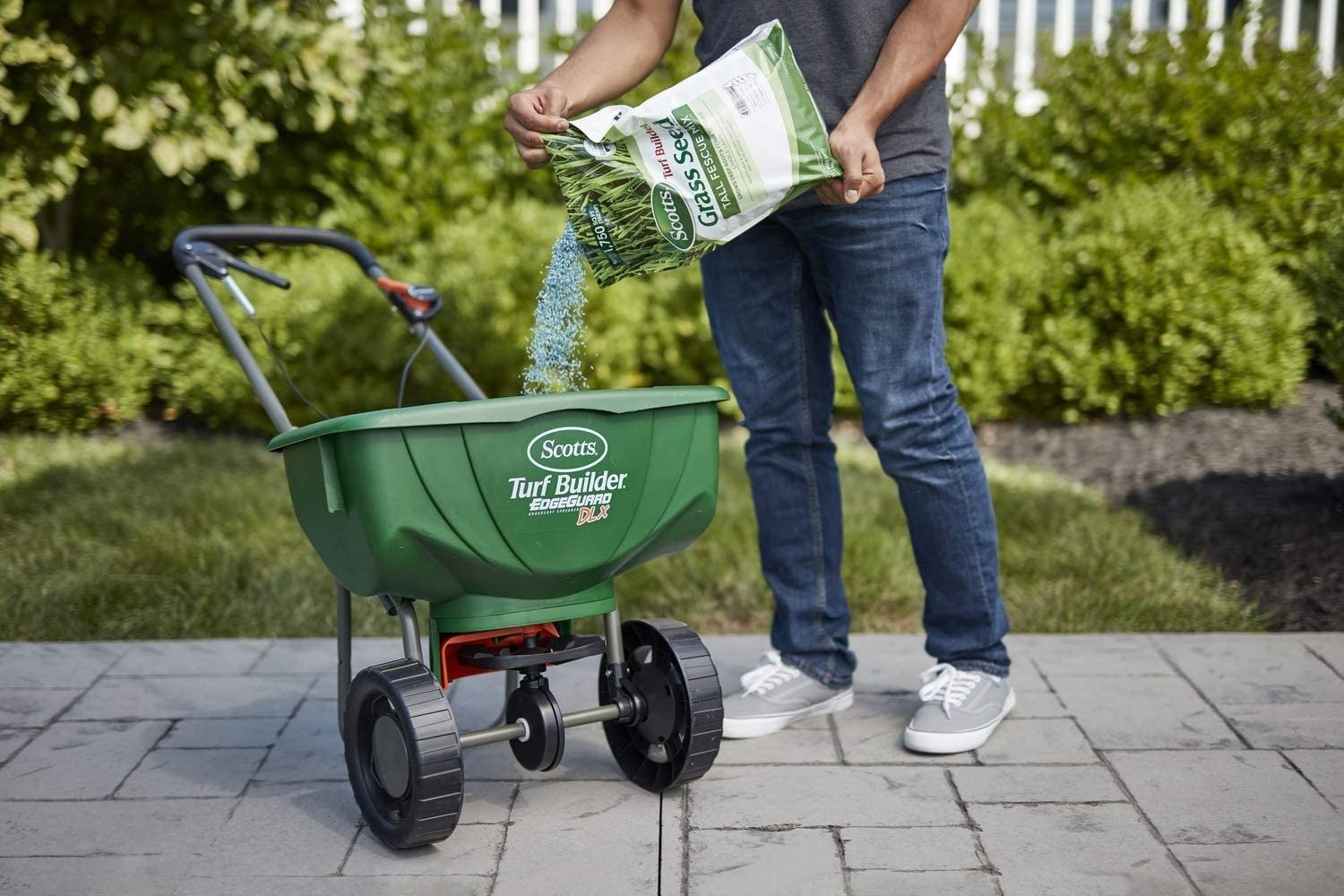
What to Consider When Choosing the Best Tall Fescue Grass Seed
Tall fescue takes its name from its growth habit, producing tall, coarse blades that grow vertically—as opposed to some species, such as buffalo grass and zoysia, whose soft blades tend to grow in all directions and bend over.
While tall fescue is a popular grass species for lawns, it’s not suitable for all locations. Tall fescue varieties thrive in USDA Zones 4 through 7, but in regions where summer temps exceed 90 degrees Fahrenheit, fescue stops growing, making this species a poor choice for southern states that see scorching summers. With that in mind, take note of the following factors when selecting the best fescue grass seed for your lawn.
Grass Type
Tall fescue is just one type within the larger family of fescue grasses. Other fescues may be grown for forage or ornamental uses, but tall fescue varieties have been improved and hybridized to produce uniform lawns. All types of tall fescue are relatively drought tolerant and disease resistant.
- Tall fescue produces wide, coarse grass blades. It grows quickly during cool spring temps but slows down during summer heat. For best results, tall fescue should be mowed to about 3.5 inches high.
- Turf-type tall fescue is slightly more heat tolerant than regular tall fescue and will fare better in USDA Zones 6 and 7. It features a somewhat more delicate grass blade and looks best when kept mowed to about 3 to 3.5 inches high.
-
Dwarf tall fescue is technically classified as tall fescue but can be mowed at a much lower height, from between about 1.5 inches to 3 inches. Like turf-type tall fescue, dwarf tall fescue features a softer, finer leaf blade than regular tall fescue.
Seeds from these three types of tall fescue are commonly sold for lawns, but they may not be labeled by type. Instead, manufacturers may label the product with terms such as “low growing,” “fine texture,” or similar words that correspond with the features of the grass.
Product Contents
Some tall fescue seed products contain a single variety of seed, while fescue seed blends typically include two or more fescue varieties that offer slightly different benefits. For example, one seed type may be for a more drought-tolerant grass and another seed type may be more heat- or shade-tolerant to offer a well-rounded blend.
In addition to fescue seed blends, consumers can purchase fescue seed mixes that contain other types of non-fescue seeds, such as bluegrass or perennial ryegrass. These blends adapt to a broader range of temperatures and soil conditions.
Still other tall fescue products have coated seeds. The coating is often designed to absorb and retain moisture, so there’s less chance the seeds will dry out before they germinate. The coating may also contain a fertilizer to help get the newly sprouted seeds off to a healthy start.
Coverage
Coverage varies when it comes to grass seed, based on the germination rate of the specific seed and whether the seed is coated. In general, 5 to 10 pounds of fescue seed are needed to cover 1,000 square feet when establishing a new tall fescue lawn. Overseeding (the practice of broadcasting grass seeds over an existing lawn to achieve denser stand of grass) rates are about half that much, about 2.5 to 5 pounds per 1,000 feet.
Ultimately, the user should consider the condition of the existing lawn. If the grass is already dense and healthy, opt for a lower coverage rate. If it’s sparse and thin, with bare patches showing, err on the side of a higher rate of coverage. Drop and broadcast spreaders allow users to adjust the application rate either higher or lower.
Germination
Tall fescue germinates more quickly than other types of seeds, which is why it is often blended in combinations with slow-germinating grasses. Tall fescue seeds sprout in about 5 to 10 days, while bluegrass seeds, for example, can take up to a month to sprout. Tall fescue roots also help stabilize the soil to help prevent slower-sprouting seeds from washing away.
Germination for tall fescue will be the quickest when the just-sown seeds are kept consistently moist but not soggy. Either a sprinkler system or a programmable hose timer can usually be set to turn on and off periodically to keep seeds from drying out, which will hasten sprouting.
Tips for Using Tall Fescue Grass Seed
Tall fescue produces a nice-looking lawn that will withstand foot traffic when the grass is healthy. A few planting and maintenance tips will help the lawn get off to a good start.
Have the soil tested by a local county extension agency to determine if it requires amending before sowing seeds. Tall fescue grows best in soil with a pH between 6 and 6.5. The agency will recommend amendments based on the outcome of the test.
All tall fescue varieties need a soft bed in which to germinate and put down roots. Loosen the soil either by turning with a shovel or rototiller to a depth of about 3 inches, break up clods, and rake smooth before planting.
Don’t alter watering as soon as seeds sprout. While tall fescue is a quick sprouter, a few seeds may be slowpokes, so maintain soil dampness for 14 to 21 days to ensure all stragglers get a chance to sprout.
Our Top Picks
A cool-season grass, tall fescue is well suited to northern lawns, but some newer turf-type varieties will grow a bit farther south. Choosing a seed product is partly a matter of personal choice—especially if you’re looking for an all-in-one product with coated seeds—but it’s also worth considering coverage and budget. The following tall fescue seed products are among the best options for establishing new lawns or overseeding existing ones.
Best Overall
Scotts Turf Builder Grass Seed Tall Fescue Mix, 7 lb.
Those wanting a heat-tolerant tall fescue product with versatile coated seeds should look into Scotts Turf Builder Tall Fescue Mix. It contains a blend of southern-bred tall fescue varieties, designed to increase the lawn’s resistance to heat. The coating has a water-retaining agent to help keep seeds moist before germination, an antifungal to reduce lawn disease, and fertilizer to boost the growth of the young sprouts.
Scotts’ tall fescue mix comes in a 7-pound bag (other amounts may be available), which seeds up to 1,750 square feet. This heat-resistant tall fescue blend is suitable for “transition” states—those states within USDA Zones 7 and the upper part of 8, such as Arkansas, Tennessee, and the upper portion of Louisiana. It’s also suitable for establishing lawns in states farther to the north, and it grows well in both sunny and shady areas of a yard.
Runner Up
Pennington Kentucky 31 Tall Fescue Grass Seed
This Pennington brand seed offers one of the most popular varieties of tall fescue, Kentucky 31, better known as K31. This specific tall fescue has a relatively light green color, is drought resistant, and grows well in moderate shade and full sun. In addition, Pennington K31 is a coated seed designed to protect young grass sprouts from fungal infections.
This tall fescue seed is best suited for northern climates in zones no farther south than USDA Zone 6. It does not tolerate high temps in areas farther south. The seed comes in a 25-pound bag, and 8 pounds will cover up to 1,000 square feet.
Best for Bare Spots
Scotts EZ Seed Patch and Repair Tall Fescue Lawns
Bare patches in a tall fescue lawn can quickly and simply be repaired with Scotts EZ Seed Patch & Repair. The seeds have been coated to protect the young grass plants from diseases, and the coating helps retain moisture to keep the seeds from drying out between waterings.
EZ Seed Patch & Repair also comes blended with a mulch that helps hold the seeds in place, reducing the risk of the seeds washing away by intense rain. The product also contains an agent that neutralizes the acidity that can be left behind from a dog’s urine and returns the soil to a healthy pH level. It’s available in a variety of sizes, and 2 pounds will reseed up to 100 bare spots caused by pets or other areas where the lawn is patchy.
Best for Lawn Thickening
Scotts Turf Builder Thick'R Lawn Tall Fescue Mix
A thin, sparse fescue lawn may benefit from Scotts Thick’R Lawn Tall Fescue Mix. Thinning grass is often the result of poor soil that lacks the nutrients to ensure healthy growth. Thick’R Lawn not only contains high-quality tall fescue seeds, but it also includes fertilizer and organic materials designed to improve soil health.
This 3-in-1 product is a solid choice when overseeding to improve grass density. The product comes in a 12-pound bag (other sizes may be available) that seeds up to 1,200 square feet.
Best for Shade
Scotts Turf Builder Grass Seed Dense Shade Mix
Developed to thrive even in deep shade, Scotts Turf Builder Dense Shade Mix seed grows just as well under deciduous trees as it does in full sun. However, unlike most tall fescue varieties that thrive in northern regions, this dense shade fescue is best suited to a horizontal strip in the approximate region where USDA Zones 6 and 7 adjoin. This region starts in the Carolinas and runs westward to take in Oklahoma and then extends to southern areas of California.
Like other Scotts seed products, these shade-loving tall fescue seeds come coated to help retain moisture during germination and protect young shoots from disease. The seed comes in a 7-pound bag that covers up to 1,750 square feet.
Also Consider
Eretz Kentucky 31 K31 Tall Fescue Grass Seed
Another K31 tall fescue variety, this Eretz product contains nothing other than K31 seeds—no coating, no fillers, and no other grass seeds. This makes the product more affordable because the seed goes farther, so users can plant a tall fescue lawn on a budget.
Eretz K31 is useful for general lawn seeding and can also be planted for use as forage for livestock or wildlife. This seed produces a very durable, drought-resistant turf that will withstand heavy foot traffic. Recommended coverage is 5 to 6 pounds per 1,000 feet and it’s available in a variety of sizes.
FAQs About Tall Fescue Grass Seed
Tall fescue is among the best choices for lawns in USDA Zones 4 through 7, and certain varieties can extend that growing area a bit. It tolerates shade and moderate drought and produces a light- to medium-green lawn. Anyone requiring more information about tall fescue grass seed should check out the answers to these frequently asked questions.
Q. Will fescue fill in bare spots?
Tall fescue does not spread to fill in bare spots. Instead, users should overseed those spots.
Q. Which is better, fescue or Kentucky bluegrass?
Both grasses have their pros and cons. Bluegrass spreads by rhizomes to create a dense turf, but it’s not as heat or shade tolerant as tall fescue.
Q. Can I mix tall fescue and Kentucky bluegrass?
Yes. In fact, many commercial seed blends contain both bluegrass and fescue.
Q. Should I put topsoil over grass seed?
No, topsoil should be used to amend the existing soil before sowing the seeds. Spreading topsoil over seeds can result in smothering the tender new grass shoots.
Q. Will tall fescue choke out weeds?
Tall fescue will not spread to choke out weeds, but by cultivating a dense lawn of fescue, weed seeds will be less likely to sprout and grow.
